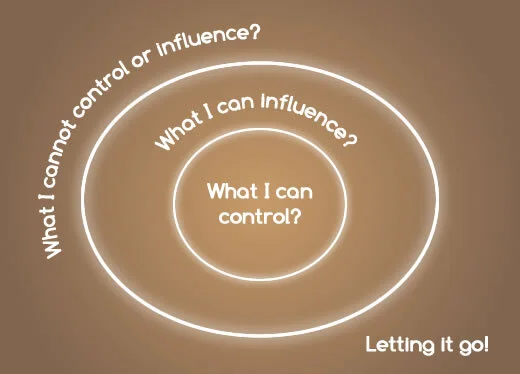6. Control, influence and letting go circle
Context: This is an excellent exercise to use to review a situation and accept what we can control, influence and need to let go of. The small area is what can be controlled in life. It is in actual fact a very limited area. Anyone can only control what they wear, where they go, who they spend time with and their own behaviour. People do not have the right to control others!
In the larger circle is the area of influence. It is larger than the ‘area of control’ yet it is still limited. Conflict in life is increased when people try to control what they can only influence or attempt to influence what is outside their control or influence. When attempting to control a situation or a person who is outside their influence and control, people have no choice but to use power. A person must force others to do what they want. This force is violence.
This misguided attempted to control issues in our lives often occurs in family separation when separated fathers are in conflict with the mother of their children. Unless the children are in actual or potential danger, each parent has the right to attempt persuasion and to influence the other parent and no right to try to force their view of ‘how things should be’ on the other. If it is not going the way you want, learn how to ‘let it go’.
Outside of the larger ovoid shape write ‘outside our area of influence and control’. There are now three distinct areas:
Our Area of Control
Our Area of Influence
Outside our Control and Influence
It is of paramount importance for the wellbeing of relationships and oneself that people clearly differentiate between these three areas. Conflict results when one party attempts to control what is outside their control or influence. To attempt to control a situation or someone that is outside someone’s control and influence they must use some type of force or power i.e.
Physical force – violence or the threat of
Intimidation - creating fear
Humiliation
Threats to do something or withdraw love and attention
Force of will
The more power/force used the greater the conflict and feelings of mistrust. Although challenging, people must learn to let go what is outside of the areas of control and influence. A simple thing to say, yet in reality it is very challenging to let go.
When to use: This exercise is used when practitioners work with men to improve cooperative ways to respond to situations. Men often over estimate the amount they can control situations and issues.
Conducting the exercise: Ask the man to think about an issue or concern. Draw two circles using the same centre - a smallish circle in the centre with a larger circle on the outside. There should be a wide space left on the outside of the circles before the edge of the paper.
Together, discuss and write down the things they can control in the situation (the answers should only refer to themselves - their feelings, actions, thoughts etc). Then, thinking of the same situation, write down all the things they can influence, but cannot control. In the outside area write down all the things they cannot control or influence. They need to let go of these things as they cannot have an impact on them.
The skill involved with letting go does not mean forgetting or ignoring. Some letting go techniques are:
Focus on your control your breathing
Acknowledge feelings but not treat them as a fact
Acknowledge the important values and goals decided upon previously
Hold on and remember significant connections in your life.
With the individual, or in the large group, discuss what is learnt.
Extension questions:
What situations in life do you misjudge the balance of control/ influence and letting go?
How do you let go of issues you feel strongly about?

